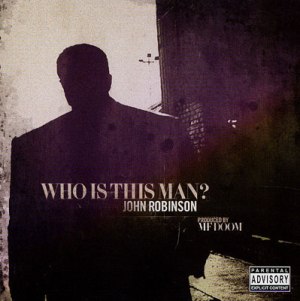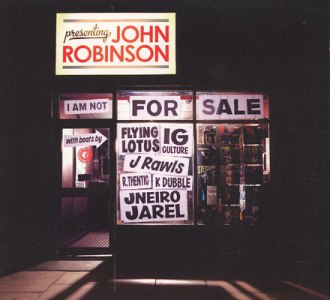
Carlos Niño & Lil Sci present What’s The Science?
Elevation (Shaman Works)
John Robinson
Who Is This Man? (High Water Music)
John Robinson
I Am Not For Sale (Fat City, FCCD028)
Who is this man, John Robinson? A veteran of the late 90s underground insurrection – you can hear him lighting up a cipher alongside Talib Kweli on Lyricist Lounge Volume One’s “Outside the Lounge†– Robinson was first known as Lil Sci of the Africanist trio Scienz Of Life. However, he has since begun using his government name to emphasize, as he recently told hiphopdx.com, “the straight away businessman/influential and positive guy. … Sci speaks about topics that would be spoken about in a spiritual classroom somewhere.â€
John Robinson and his namesake are kindred spirits. Both approach lyricism as a kind of extended freestyle, riffing on a theme while coolly riding a beat. However, his identity crisis reflects key stylistic differences among his recent trio of albums, all of which have appeared in less than a year. Elevation is co-authored with Carlos Niño, one of the men (along with composer Miguel Atwood-Ferguson) behind the much-publicized A Suite for Dilla tribute concert in Los Angeles. Who Is This Man is helmed by mentor and frequent collaborator MF Doom. And I Am Not for Sale boasts a murderer’s row of progressive beat makers, including Jneiro Jarel, Flying Lotus, IG Culture and J. Rawls.

Initially released via iTunes last May, and then properly issued on vinyl and CD in the fall, Elevation finds Robinson using his Lil Sci alias as an advocate for abstraction, exploring the metaphysics of song. There are several paeans to hip hop, which he celebrates as “vibrations, love, tones, energy.†He refers to himself as a chemist, but he professes to be a master of language instead of physics.
As Robinson embarks on his lyrical flights of fancy, Nino composes a background that shifts from Afrocentric drums (“Honor, Courage and Rhythm,†where Nino borrows an instrumental, “Life Force Contact,†from his Ammoncontact project) to elegant piano jazz (the lovely “Freedom,†which samples Pharoah Sanders and includes a lovely chorus from Tiffany Paige). He doesn’t produce all of the tracks – Atwood-Ferguson, Flying Lotus and Daedelus contribute music – but his guiding vision keeps Elevation from dissembling into a patchwork of good intentions and saccharine melodies.
With such strong sounds to guide him, Robinson’s words hit with real power. “We gotta look up my people of the sun, children of melanin/Clear blue heavenly skies, it’s so embellishin’,†he rhymes on “Higher.†Granted, Elevation isn’t for hardcore rap fans who shun Afrocentric styles and “that space shit,†as Prodigy of Mobb Deep so memorably put it. As Robinson raps, “They say, sex, drugs and rock & roll/We say, love, hugs and hip hop soul.â€

If Elevation feels fresh and bright like new romance, then Who Is This Man feels world-weary and casual. Two old friends collaborate with ease as MF Doom cooks up uncomplicated loops from familiar-sounding sources — on “There She Goes†he uses Ramsey Lewis’ “Julia,†which All Natural also used on its indie classic “50 Years.†Meanwhile Robinson calls himself a “mic gladiator like Spartacus†on “Shrink Rap.†But why does he waste energy criticizing mainstream rappers and “corporations caking off the mis-education, from the TVs to your radio station,†when the near-collapse of the recording industry, coupled with a vibrant independent network of labels and musicians, has rendered it artistically irrelevant? And if he’s so angry about it, why not call out some of its villains by name instead of weaving aimless generalities?
In the aforementioned hiphopdx.com interview, Robinson claimed that the album was recorded back in 2004, and was subsequently delayed for a variety of reasons before German label Project: Mooncircle issued it last fall. (In January, a U.S. edition appeared via High Water Music.) In the interim, Doom re-used its beats for both legal (Ghostface Killah’s Fishscale) and semi-legal projects (Trunks’ Internet EP Unicron).
But Doom’s penchant for recycling beats is only part of the problem. Few of the album’s tracks pop and crackle with excitement. (One exception is “The Truth,†where Robinson builds with Stahhr and Invizible Handz over a track made out of hard bass and maniacal giggling voices.) Robinson proudly explains that hip hop “is throwback music, jazz, soul, blues, whatever you choose it†on “Outta Control.†But save for “Black Gold,†an intriguing number where Robinson discusses the tyranny of the oil market over an Arthur Veroçai sample, the duo sticks with classical “true school†production values and hoary anti-establishment clichés. As a result, they sound just as narrow-minded as “the true bloodsuckers of the poor.â€

Years later after recording the Who Is This Man, Robinson is still shadowboxing with unnamed rap antagonists. The title, I Am Not for Sale, is a dead giveaway. “Money drugs and hoes all these nickel-and-dime flows/Deaf dumb and blind then they wonder why crime grows,†he rues on the title track. “I’m not an idol, I’m an icon figure/Here to make the small minds think much bigger.†He refers to hip hop as if it was a beautiful but wayward woman that beguiles and disappoints him. On “Mascot,†he and underground soul vocalist Peter Hadar makes their sentiments plain: “Hip hop I love you.†Then Robinson opines on “Touch ‘Em,†“Hip hop’s not dead, it’s just gotten tremendous big/But it’s being caressed by the wrong palms.â€
If I Am Not For Sale doesn’t sound ossified as Who Is This Man, it’s because Robinson works with different producers, each bringing a new perspective. J. Rawls creates a lush soul vibe for “Touch ‘Emâ€; K Dubble lays out a nice synth beat that heightens Hadar’s dramatic vocal; and Flying Lotus mixes exotic rhythms with cool jazz on “Fly Prezidente.†Robinson’s next level collaborators help temper his dictatorial tone. “They can’t stop the movement,†he asserts on “Stop & Think.â€
With a brisk, weathered cadence that communicates wisdom and authority, and an ability to flip lyrics out of simple, effective words instead of dictionary terms, Robinson is a prodigiously talented rapper. Recording two albums in a year – and releasing a third in the same period – is an impressive feat. Why is Robinson so worried about how lesser rappers treat H.E.R.? Hip hop is alive and well – all he has to do is look in the mirror.
Photo of John Robinson by Robert Adam Mayer.


Pingback: Rap Talk » Bidness: John Robinson
Pingback: J.Rawls and John Robinson - It’s Jay Are - Beatlife
Pingback: Can u say PROLIFIC?